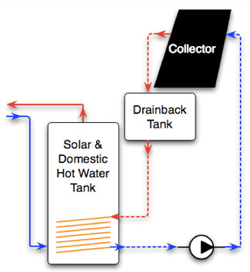How Solar Hot Water Works
Solar thermal panels, also known as solar hot water collectors, transfer heat energy from the sun to water.Solar water heating systems are connected to an existing domestic water heating system. In the event that the solar storage tank cannot meet hot water demand, the existing hot water heater is used.
Pressurized Anti-Freeze System
Because the heat exchanger transfers heat from the glycol to potable water in the storage tank, these two liquid substances never mix.The circulating heat-collection fluid operates in a pressurized self-contained loop, with very little or no noise.This type of closed-loop system requires additional maintenance, as the polyproplene glycol must be changed every 3 to 5 years. |
Drainback System
The circulating heat-collection fluid in this system operates in a non-pressurized closed loop, only moving between the collectors and a heat exchanger. The heat exchanger transfers heat to potable water in the tank. Nominal operation noise is evident in non-pressurized systems. Drain-back systems require less maintenance compared to other closed-loop systems; because water is the heat transfer liquid, it does not require periodic changing. |







